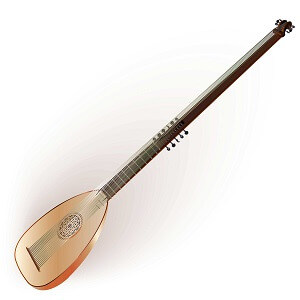Chitarrone
 The Chitarrone is a kind of lute that was popular around 1600. It has an extended neck to hold the very long bass strings. These strings have no fingerboard, and are played "open" - each string sounding only its own pitch. The high (short) strings have their own fingerboard with frets, and are fingered like those of the modern guitar.
The Chitarrone is a kind of lute that was popular around 1600. It has an extended neck to hold the very long bass strings. These strings have no fingerboard, and are played "open" - each string sounding only its own pitch. The high (short) strings have their own fingerboard with frets, and are fingered like those of the modern guitar.
The chitarrone had six to eight strings running over the fingerboard to a pegbox (the part of the instrument in which the tuning pegs are set) positioned midway in an extended neck. The instrument had six to eight additional bass strings, or diapasons, lying off the fingerboard and running to a second pegbox at the end of the neck. Having a sonority approaching that of the contemporary harpsichord, it was used as a basso continuo instrument in 17th-century chamber-music ensembles.
Theorboes were developed during the late sixteenth century, inspired by the demand for extended bass range for use in opera developed by the Florentine Camerata and new musical works based on basso continuo, such as Giulio Caccini's two collections, Le nuove musiche (1602 and 1614). Musicians adapted bass lutes (c.80+ cm string length) with a neck extension to accommodate open (i. e. unfretted) bass strings, called diapasons or bourdons. The instrument was called both chitarrone and tiorba. Although theorbo and chitarrone are virtually identical, they have different etymological origins, chitarrone being a descendant of chitarra italiana (hence its name).